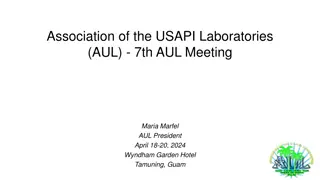Understanding the Objectives of Online Laboratories in STEM Education
Online laboratories offer interactive experiments over the internet, providing remote and virtual practical experiences in STEM education. The OpenSTEM Labs project aims to explore various activities and outcomes in experiments, focusing on classification schemes and learning objectives. The purpose of laboratory work in STEM education, as defined by the Gatsby Charitable Foundation, is to teach scientific principles, enhance theoretical understanding through practical experience, develop practical skills, motivate students, and cultivate higher-level skills. Online laboratories are defined as interactive experiments provided online and can be remote, virtual, or imitations of real experiments. OpenSTEM Labs deliver authentic practical experiences to distance learning students through a wide range of experiments.
Download Presentation

Please find below an Image/Link to download the presentation.
The content on the website is provided AS IS for your information and personal use only. It may not be sold, licensed, or shared on other websites without obtaining consent from the author. Download presentation by click this link. If you encounter any issues during the download, it is possible that the publisher has removed the file from their server.
E N D
Presentation Transcript
What are the learning objectives of online laboratories? Helen Lockett (helen.lockett@open.ac.uk), Director of the OpenSTEM Labs Team members: Kay Bromley, Kevin Gowans, Duncan McNicholl, Claire Richardson and James Smith
Overview eSTEeM project aim and objectives Purpose of laboratory work in STEM education Online Laboratory definitions Brief introduction to the OpenSTEM Labs Classification scheme for online laboratories and their learning objectives Project findings Summary 2
eSTEeM Project aim and objectives Aim: To explore the breadth of activities, skills and educational outcomes developed in OpenSTEM Labs experiments Objectives: Understand how remote and virtual laboratories are classified in the literature Develop a classification scheme for OpenSTEM Labs experiments and their learning objectives Create a database of OpenSTEM Labs experiments to help us understand the range of experiments available and their learning objectives Develop a design tool to aid development of new OpenSTEM Labs experiments 3
What is the purpose of laboratory work in STEM education? Gatsby Charitable Foundation defines the purposes of practical science education as: 1. to teach the principles of scientific inquiry; 2. to improve understanding of theory through practical experience; 3. to teach specific practical skills, such as measurement and observation, that may be useful in future study or employment; 4. to motivate and engage students; 5. to develop higher level skills and attributes such as communication, teamwork and perseverance https://www.gatsby.org.uk/uploads/education/reports/pdf/good-practical-science-report.pdf 4
Online laboratories definitions interactive experiments provided over the internet (Zutin et al., 2010) Online Laboratory Remote Laboratory Virtual Laboratory real physical laboratories accessed through a network... (Rivera and Petrie, 2016) Imitations of real experiments... (Adapted from Ma and Nickerson 2006) 5
OpenSTEM Labs The OpenSTEM Labs are the STEM Faculty s online laboratories and deliver authentic practical experiences to our distance learning students The OpenSTEM Labs deliver both remote and virtual experiments and have more than 100 experiments with more than 10,000 users/year 6
Classification scheme for online laboratory types - 1 7 Developed from Zutin et al. (2010)
Classification scheme for online laboratory learning objectives Demonstrate competence in operating apparatus Identify and deal with health and safety issues Communicate effectively about laboratory work Work effectively in teams Behave with high ethical standards Use human senses to gather information Design, build, or assemble a product Develop subject knowledge and understanding Apply appropriate instrumentation to make measurements Use theoretical models to predict behaviour Devise an experimental approach Collect data Analyse and interpret data Identify unsuccessful outcomes and learn from failure Demonstrate creativity in problem solving (Developed from Feisel and Rosa (2005) and Brinson (2015) 9
Classification scheme for online laboratory learning objectives Demonstrate competence in operating apparatus Identify and deal with health and safety issues Communicate effectively about laboratory work Work effectively in teams Behave with high ethical standards Use human senses to gather information Design, build, or assemble a product Develop subject knowledge and understanding Apply appropriate instrumentation to make measurements Use theoretical models to predict behaviour Devise an experimental approach Collect data Analyse and interpret data Identify unsuccessful outcomes and learn from failure Demonstrate creativity in problem solving (Developed from Feisel and Rosa (2005) and Brinson (2015) 10
OpenSTEM Labs experiments mapped in the project Twenty three experiments were mapped in the project All the experiments in three core OpenSTEM Labs modules: SDK100 Science and health: an evidence-based approach SXPS288 Remote experiments in physics and space T212 Electronics: sensing, logic and actuation Experiments from other biology and engineering modules: SXHL288, SK299, T271, T272, S112 12
Initial findings activity types Discipline Total number of activities 7 10 Number of Remote activities 0 10 Number of Virtual activities 7 0 Health/ Biology Engineering/ Electronics Earth sciences Astronomy/ Physics Total 1 5 0 4 1 1 23 14 9 13
Summary This project has helped us to understand the bread of learning objectives and interaction types in OpenSTEM Labs experiments Analysing existing experiments using can help us to identify gaps in learning objectives The activity catalogue and database will help disseminate information about existing experiments and encourage reuse The classification schemes can be used as a checklist by module teams designing new online experiments to ensure that a range of learning objectives and interactions are considered Please get in touch if you would like to know more! 15
Useful Links eSTEeM report and associated documents: https://www.open.ac.uk/scholarship-and- innovation/esteem/projects/themes/technologies-stem-learning/investigation-the- breadth-learning-outcomes-and-skills THE Article about designing online experiments: https://www.timeshighereducation.com/campus/when-use-online-laboratories- stem-teaching-and-why 16
References 1. Feisel, L. D. and Rosa, A. J. (2005) The Role of the Laboratory in Undergraduate Engineering Education , Journal of Engineering Education, 94(1), pp. 121 130. 2. Brinson, J.R. (2015) Learning outcome achievement in non-traditional (virtual and remote) versus traditional (hands-on) laboratories: A review of the empirical research. Computers and Education, (87), pp. 218 237. 3. Nickerson, J.V., Corter, J.E., Esche, S.K. and Chassapis, C., 2007. A model for evaluating the effectiveness of remote engineering laboratories and simulations in education. Computers & Education, 49(3), pp. 708-725. 4. Zutin D.G., Auer M.E., Maier C., and Niederstatter M., Lab2go A repository to locate educational online laboratories, in Proc. of IEEE EDUCON 2010 Conference: The Future of Global Learning Engineering Education, Madrid, Spain, 14-16 April 2010, IEEE, pp. 1741-1746. 17























